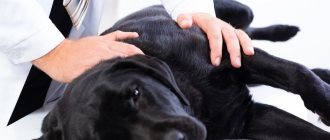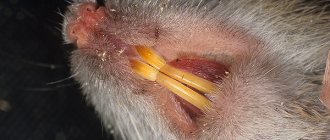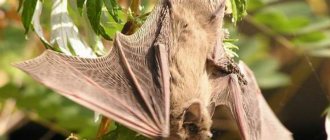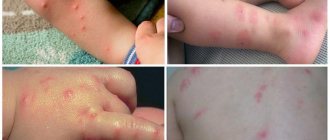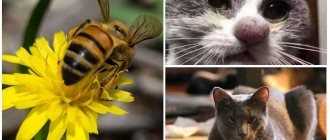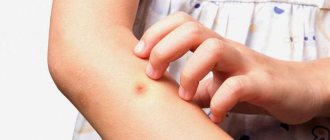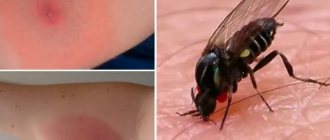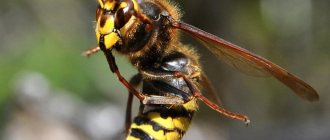Mouse bite
Mice, like other rodents, are dangerous to humans - they are carriers of infectious diseases. Pathogens that infect rodents can be transmitted through nutrition and airborne droplets, but the most dangerous is considered to be contact. If a mouse bites until it bleeds, you should seek medical help as soon as possible. The doctor will not only tell you what to do if you are bitten by a mouse, but will also give you a referral for tests, tetanus vaccination, and prescribe treatment.
The main dangers of mouse bites
Mice show aggression only when fighting for their own lives or the lives of their offspring. Sometimes a mouse may bite in agony, so a rodent caught in a mousetrap should not be handled with bare hands.
Diseases that can be contracted from mice pose a mortal danger to humans. It is important not to wait for signs of the disease to appear (symptoms do not appear immediately), but to go to the emergency room as quickly as possible.
Pathogens enter the human body through damaged skin with the saliva of a sick animal. Most often, wild and field mice suffer from the following pathologies:
- Leptospirosis. The incubation period is up to 14 days. This is an infectious disease caused by the spiral-shaped bacterium Leptospira, which belongs to the class of spirochetes of the genus Gram-negative. The disease disrupts the functioning of the nervous system, kidneys, and liver.
- Sodoku. The incubation period is up to 14 days, sometimes up to 2 months. The causative agent of the disease is spirillum minus. Manifested by fever, skin rashes, and attacks of arthritis. A deadly disease.
- Pseudotuberculosis. The incubation period averages about 8 days. There are several forms - some are dangerous to human life.
- Plague. The disease is characterized by extreme contagiousness and high mortality.
- Tularemia. The causative agent of zooanthroponotic infection is the bacterium Francisella tularensis. The incubation period can last 21 days, but on average it is 3–7 days. Fever lasts up to 30 days. Complications of the disease are meningoencephalitis, tularemia pneumonia, peritonitis, pericarditis, abscesses.
Recent studies have revealed that mouse mammary tumor virus, transmitted by rodents, can cause breast cancer in humans. Mice are often infested with blood-sucking arthropods, which are easily transmitted to humans.
Do mice bite?
In fact, gray eared cats, unlike their closest relatives, rats, are cowardly creatures and will not just attack a person. Mice show aggression only in a hopeless situation, when they have to defend themselves to protect their own skin.
Often, an animal reflexively uses its teeth while in its death throes, which is why it is undesirable to approach them at such moments, and even more so to touch the “suicide bomber” with bare hands.
If we are talking about decorative pets, then they bite only under stressful conditions, for example:
- when kept in a small house;
- with great crowding;
- when living in a noisy room;
- in a moment of fright.
Although decorative mice are often sterile in terms of infections, their bites are also potentially dangerous: pathogenic microflora can enter the wound and a strong inflammatory reaction will begin.
First aid
In any situation, a person who has been bitten by a mouse (even a domestic one) needs to competently provide first aid.
Afterwards, you should immediately go to the doctor, if possible taking the attacked rodent in a container or jar so that a laboratory can study whether the mouse could cause any infection.
If the skin is damaged to the point of bleeding, the algorithm for providing first aid after contact with a mouse should be as follows:
- You need to rinse the damaged area with running water and try to squeeze out as much blood as possible from the deep bite. The procedure should last at least 15–20 minutes. You can use laundry soap.
- Treat the damaged area with hydrogen peroxide. You can use iodine, alcohol, vodka or cologne if peroxide is not on hand.
- Apply a sterile dressing (bandage or bactericidal patch) to the wound.
Further assistance is provided by doctors. After examining the wound and assessing the condition of the victim, the specialist prescribes preventive vaccination against tetanus. To reduce the risk of infection, a course of antibiotic therapy is prescribed.
Not all diseases transmitted through a bite manifest themselves immediately, so the victim is registered. You will have to be under medical supervision for at least a month - most infections have a long latent period.
How can you get infected from a rodent bite?
Despite the slight blood loss, a mouse bite is more dangerous than it seems at first glance. Animal saliva often contains pathogens of serious infections that these animals carry. Infection may not be detected immediately, as symptoms appear later.
Diseases that can be transmitted by a mouse bite:
- Rabies. The first signs of the disease are headaches, a slight increase in temperature, and a depressed mood. As the disease progresses, hallucinations and epileptic seizures may appear. If treatment is not started on time, death occurs due to the destruction of brain cells. Rabies from a mouse bite is treated with rabies immunoglobulin vaccine.
- Tularemia. The first symptoms may appear either after a day or after a month. The temperature rises to +38...400C, weakness and muscle pain are felt. Then the lymph nodes become inflamed, a rash appears on the skin, and blood pressure is reduced. Secondary pneumonia may develop.
- Leptospirosis. Primary symptoms are similar to tularemia. The differences are puffiness, redness of the face and neck, and an increased vascular pattern in the eyes. At the second stage, internal organs are affected - kidneys, liver, nervous system. The skin becomes jaundiced.
- Tick-borne encephalitis. The disease manifests itself on the 5th–6th day of infection immediately in an acute form. Sometimes patients can name the exact time when they became ill. Chills appear, temperature rises, weakness. If left untreated, the virus can affect the brain and spinal cord.
- Plague. The risk of being bitten by an animal infected with this disease is minimal, since the animals themselves die from it on the second day.
Carries diseases
The listed diseases do not reflect the entire list that a mouse bite can lead to, so you should not delay going to the doctor.
Consequences of a mouse bite
People do not consider the bite of a small rodent dangerous, because rabies is transmitted through the bites of large animals, and no cases of infection with this dangerous disease from mice have yet been recorded.
Mice live in basements and garbage dumps. Rodents are omnivores, so their mouths are a breeding ground for pathogenic microorganisms. If the bite is deep, the bacteria can cause sepsis.
Sepsis
Most often, human hands suffer when handling rodents carelessly. In deep lacerated wounds, suppuration will certainly begin, so disinfection measures should be taken to ensure the release of pus.
Contact with a wild rodent can cause an allergic reaction even in people who have not previously complained of such symptoms. This may include redness, swelling, rash, or more severe symptoms.
Pre-exposure (pre-exposure) immunization
- Indicated for persons at high risk associated with their profession (laboratory workers directly working with the rabies virus, veterinarians).
- Travelers who may be at risk of exposure to the virus.
- Persons living in areas where rabies is endemic and where the availability of anti-rabies biological products is limited.
It should also be remembered that for any injuries that damage the integrity of the skin and mucous membranes, animal bites, burns, frostbite, etc. emergency prophylaxis of tetanus is carried out.
Prevention measures
When listing common diseases and infections, the carriers of which always live in a person’s neighborhood, it is necessary to note the basic precautions that will protect you and your family from unwanted symptoms.
Hand washing
- Personal hygiene, which includes washing hands after working with soil, exposed objects, as well as after walking and visiting the toilet;
- Washing fruits and vegetables, as well as greens, especially if you bought them in a store, since it is not known where they were stored and where they were brought from, before reaching the counter;
- Drinking boiled or filtered drinking water;
- Regular deworming of pets, dogs and cats;
- Timely testing for the presence of parasites in your body;
- Eliminate food items chewed by animals from the diet;
- If you have a vegetable storehouse, then if mice and rats are found, you need to take measures to bait them;
- Constant cleaning of the premises.
Treatment of the wound
For any injury, it is important to thoroughly rinse the wound to remove as many pathogenic microbes as possible with running water. Before the procedure, you should squeeze out a little blood from the wound; along with it, some of the infected rodent saliva will flow out.
Washing the wound is most effective when using laundry soap. The alkali in the product neutralizes the effects of many viruses and bacteria. It is recommended to clean the wound for 15-20 minutes. Deep punctures should be washed with a stream of soapy water using a syringe or syringe.
Superficial scratches and wound edges should be disinfected with 3% hydrogen peroxide or any alcohol solution. After treatment, all that remains is to stick a patch on the damaged area or bandage the wounded area with a sterile bandage with an antiseptic (furacilin).
There is a misconception about the destruction of viruses by cauterizing the bite site. This procedure is painful and does not remove the infection from the wound. The victim receives additional injury in the form of a burn.
When treating a mouse bite, special attention should be paid to people prone to severe allergic manifestations.
A foreign protein that enters the body can cause severe symptoms of irritation:
- swelling of the injury site;
- severe redness of the bite;
- skin rash.
Taking an antihistamine will prevent the body’s protest reaction and improve the victim’s well-being.
Proper first aid reduces the risk of infection and the development of an inflammatory process. But thorough infection prevention is only possible in a medical facility.
What to do if a rodent bites your pets
Animals often bite cats and dogs, defending themselves from their attacks. If a rat has bitten a dog or cat, you must immediately wash the bite site with hydrogen peroxide. After this, seek help from a veterinarian.
It is good if your pet has a rabies vaccination. In this case, he is not in danger of contracting this terrible disease. But there remains a high probability of contracting other infections. Therefore, only a specialist should decide on further measures to treat the animal.
If it is not possible to immediately go to a veterinary hospital, start giving the animal antibiotics (Ofloxacin several times a day for 5 days) and treat the affected area with an antiseptic.
Plague
People who are more or less familiar with world history have, of course, heard about the largest plague epidemics in the Middle Ages, when the mortality rate in infected settlements exceeded 95%. The famous plague epidemics, which claimed millions of lives and devastated vast territories, left a deep mark on the history of all mankind. And the last pandemic was not as long ago as it seems - only in the middle of the 19th century in China! Moreover, large outbreaks of the disease were recorded in India in the 20th century, and in a number of countries (especially Africa and Asia, although there are natural outbreaks even in Russia) they still occur to this day.
We, of course, are not Africa, and with the development of medicine, the mortality rate of the disease has now been reduced to approximately 5-10%, but it would not hurt to know about the possible danger.
The causative agent of plague is the bacterium plague bacillus, and its sources and carriers are all kinds of rodents, both wild and synanthropic (accompanying humans), as well as rat fleas. The “gate” of infection is skin or mucous membranes damaged by a bite. An infected person, in turn, becomes a potential source of a disease in which transmission of the pathogen to another person or animal, depending on the form of the disease (and there are several of them), can be carried out by airborne droplets or contact.
The clinical picture of plague varies, but in any case it is an acute infectious disease that occurs with an extremely severe general condition, fever, damage to the lymph nodes, lungs and other internal organs, often with the development of sepsis.
Vaccination
In the nearest trauma center or treatment room of the clinic, after a medical examination of the patient, the injury will be thoroughly treated with medications.
When bitten by a decorative mouse, primary measures are enough to prevent complications. Damage from a wild rodent is more dangerous. Antibacterial therapy, vaccination against tetanus and rabies are required. Treatment with folk remedies is inappropriate.
After the procedures are prescribed, the first injection of rabies vaccine is given on the day of treatment, then according to the schedule for the next three months.
Information about the infection of the bitten animal is important. If the rodent was caught after the attack, its delivery alive to the laboratory will allow us to identify all types of infections that the mouse could potentially infect after the bite. Vaccination is stopped when the animal is not a carrier of the rabies virus.
The victim’s refusal to visit a doctor carries a high risk of developing the active phase of the disease. Many symptoms of infectious diseases initially resemble a common cold. It can be difficult for a doctor to make an accurate diagnosis based on a vague clinical picture. When characteristic signs of diseases appear, time for effective measures is lost.
Refusal of vaccination and medical control is dangerous due to severe chronic diseases, relapses, and disability of the victim.
Methods of transmission of diseases from mice
Infectious diseases are transmitted from mice to humans under the following circumstances:
- cleaning rooms with mouse excrement;
- work in vegetable warehouses, warehouses where mice are found;
- eating fresh cabbage and carrot salads from a vegetable warehouse with mice;
- due to close contact with an infected mouse.
In the same way, there is a chance of getting infected from rats. Both types of rodents can easily get along in the same area.
Infection from mice reaches the mucous membranes and penetrates into lesions on the skin.
In some cases, with a high concentration of the pathogen in the soil (mice excrement), transmission can occur by airborne droplets during excavation work.
How to avoid being bitten?
Basic safety rules will in most cases help avoid rodent bites. To prevent the mouse from attacking, you need to:
- Avoid places where they can be found in large numbers. As a rule, these are landfills and basements of multi-story buildings. In rural areas, rodents accumulate in granaries.
- At the first sign of mice appearing in the house, carry out deratization.
- Do not attempt to touch animals with bare hands, even when they appear dead.
- If there are decorative mice in the house, then you need to create comfortable conditions for them and try not to pick them up.
- When planning to clear out trash from an attic or basement, you should wear thick clothing, boots, and work in canvas gloves. Thus, the risk that a mouse will be able to reach human skin with its teeth will be reduced several times.
- When traveling outside the city, you should carefully choose a vacation spot, especially near bodies of water.
